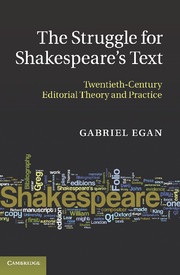Book contents
- Frontmatter
- Contents
- Preface
- Acknowledgements
- A note on references, quotations, names and pronouns
- Introduction
- 1 The fall of pessimism and the rise of New Bibliography, 1902–1942
- 2 New techniques and the Virginian School: New Bibliography 1939–1968
- 3 New Bibliography 1969–1979
- Intermezzo: the rise and fall of the theory of memorial reconstruction
- 4 New Bibliography critiqued and revised, 1980–1990
- 5 The ‘new’ New Bibliography: the Oxford Complete Works, 1978–1989
- 6 Materialism, unediting and version-editing, 1990–1999
- Conclusion: the twenty-first century
- Appendix 1 How early modern books were made: a brief guide
- Appendix 2 Table of Shakespeare editions up to 1623
- Appendix 3 Editorial principles of the major twentieth-century Shakespeare editions
- Works cited
- Index
Conclusion: the twenty-first century
Published online by Cambridge University Press: 06 December 2010
- Frontmatter
- Contents
- Preface
- Acknowledgements
- A note on references, quotations, names and pronouns
- Introduction
- 1 The fall of pessimism and the rise of New Bibliography, 1902–1942
- 2 New techniques and the Virginian School: New Bibliography 1939–1968
- 3 New Bibliography 1969–1979
- Intermezzo: the rise and fall of the theory of memorial reconstruction
- 4 New Bibliography critiqued and revised, 1980–1990
- 5 The ‘new’ New Bibliography: the Oxford Complete Works, 1978–1989
- 6 Materialism, unediting and version-editing, 1990–1999
- Conclusion: the twenty-first century
- Appendix 1 How early modern books were made: a brief guide
- Appendix 2 Table of Shakespeare editions up to 1623
- Appendix 3 Editorial principles of the major twentieth-century Shakespeare editions
- Works cited
- Index
Summary
Our account of editorial theory and practice has almost arrived at the present, so the remaining contributions form essentially the current state of the debate and will be treated thematically. We begin with an examination of how New Textualism has influenced mainstream Shakespeare studies – the new series it spawned having already been discussed (pp. 190–7 above) – and then consider the effect of Lukas Erne's powerful and as yet unanswered argument that Shakespeare was not exclusively a man of the theatre, being concerned also with his growing readership. The closing remarks address the future of the theory and practice of editing Shakespeare, focussing on the problems that arise from Shakespeare's practice of co-authorship, the routine theatrical cutting of his plays, and his being a literary as well as a dramatic author.
THE EFFECTS AND LIMITS OF NEW TEXTUALISM
New Textualism began visibly to encroach upon mainstream New Bibliographical practice when Jill L. Levenson edited Romeo and Juliet for a volume in the single-play Oxford Shakespeare series (p. 167 above; Appendix 3 below) by treating Q1 (1597) and Q2 (1599) as distinct versions and giving modernized texts of each (Shakespeare 2000e). New Bibliographers called Q1 a bad or illicit edition because it is short, lacks a Stationers' Register entry, and was poorly printed. Levenson found that only the first of these claims stood up to scrutiny; it is simply a short quarto.
- Type
- Chapter
- Information
- The Struggle for Shakespeare's TextTwentieth-Century Editorial Theory and Practice, pp. 207 - 230Publisher: Cambridge University PressPrint publication year: 2010

